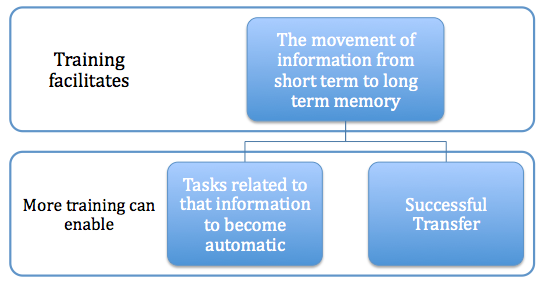This is the fourth in the five steps of efficient learning that are outlined here.
Train: Train/Practice/Review, all of these words mean the same thing. This last step of efficient learning can take as little or as much time as you like, it depends on what you want out of it. If you only want to remember the info for a multiple choice test tomorrow, your requirement for training will be minimal. If you want to remember it for life, this will be an ongoing process. This article first deals with why you should bother training then moves on to how to do it.
Why Train?
Training facilitates the following process, each of outcomes is discussed below1.
In the following I refer quite a bit to the importance of storing things in long term memory in order to make space in your working memory for thinking. If this doesn’t make sense to you yet. Read this article on how knowing things facilitates Critical Thinking.
From Short Term to Long Term Memory
This is the difference between remembering something for only a short period of time and having it available to call upon whenever you need it. As I explain in the critical thinking article I linked to above, without storing information in your long term memory you’ll be clogging up your working memory and be significantly compromising your ability to solve problems. Unless you’ve remembered it you simply don’t know it.
Making it Automatic
 I remember one time when I was learning to drive I was travelling along the highway with my friend in the back seat and my mum suggested that I change lanes to take an exit. I checked my mirrors and started to do a head check when I felt the steering wheel move. I looked forward again and mum was holding the steering wheel. I glanced at my mate in the rear view mirror and he had a very worried look on his face. I had been veering off the road!
I remember one time when I was learning to drive I was travelling along the highway with my friend in the back seat and my mum suggested that I change lanes to take an exit. I checked my mirrors and started to do a head check when I felt the steering wheel move. I looked forward again and mum was holding the steering wheel. I glanced at my mate in the rear view mirror and he had a very worried look on his face. I had been veering off the road!
At this point in my learning-to-drive process I understood how to do it and I could physically drive. All the info of the process was stored in my long term memory, but the process wasn’t automatic for me yet. It took conscious concentration for me to drive and I’d have to go through the steps in my head. eg: when taking off: “clutch in, turn car on, indicate, get the revs up, let the clutch of slowly till it bites, ease the hand break off, check mirror, shoulder check, move out onto road”. This was an attention consuming process and meant that if I got distracted by something my passengers were in a risky position!
This is the same for all learning. For something like maths, we want to make the basic rules of algebra automatic so that we can think about how to solve new problems without having our working memory clogged up with wether you need to divide or multiply both sides by 5 to isolate x. Training to the point of automaticity is vital for taking your learning to the next level and especially for performing well in stressful situations.
Transfer
I mentioned transfer in step 3: Understand. Transfer occurs when you’re able to apply an idea or concept to an unfamiliar situation because you understand it well enough. Transfer can happen shortly after a concept has been transferred to long term memory, but training helps to cement it, and automaticity frees up working memory space so that you can think of new and more creative ways and apply the concept to novel situations.
Other than just being able to solve questions that we’ve never seen before, there are other ways that we can test for transfer. One way to test for transfer is to ask if we could think of a new situation in which the principle in question could apply, this new situation could be just an example, or it could be in the form of an analogy.
 eg: If your english class has just been exploring the concept of Irony*, the teacher may ask ‘can anyone think of any new examples of ironic situations?’. A student may reply, ‘You’re walking to work then a piano falls on your head’ . If this is the case, you could conclude that this student hasn’t quite grasped the concept solidly enough for transfer to occur. If, however, they suggest ‘You poke your eye out whilst putting on your safety glasses’ or ‘The ambulance set out to save the lady but ran over a man on the way’ it would be clear that transfer had occurred.
eg: If your english class has just been exploring the concept of Irony*, the teacher may ask ‘can anyone think of any new examples of ironic situations?’. A student may reply, ‘You’re walking to work then a piano falls on your head’ . If this is the case, you could conclude that this student hasn’t quite grasped the concept solidly enough for transfer to occur. If, however, they suggest ‘You poke your eye out whilst putting on your safety glasses’ or ‘The ambulance set out to save the lady but ran over a man on the way’ it would be clear that transfer had occurred.
*Irony: A condition of affairs or events of a character opposite to what was, or might naturally be, expected; a contradictory outcome of events as if in mockery of the promise and fitness of things. (In French ironie du sort.) -Oxford english dictionary.
How to Train
 The most important and most ignored principal of revision is to SPACE YOUR PRACTICE. This is the case for mental tasks. For physical tasks ‘cramming’ can often be effective because muscle memory is different to mental memory. The best way to space out your practice is by using Spaced Repetition Software. If you have read many of the articles on this blog before then you should be familiar with the software Anki by now. This article I put together about Anki is one of the first articles I ever wrote on this blog, and it remains one of the most relevant.
The most important and most ignored principal of revision is to SPACE YOUR PRACTICE. This is the case for mental tasks. For physical tasks ‘cramming’ can often be effective because muscle memory is different to mental memory. The best way to space out your practice is by using Spaced Repetition Software. If you have read many of the articles on this blog before then you should be familiar with the software Anki by now. This article I put together about Anki is one of the first articles I ever wrote on this blog, and it remains one of the most relevant.
Once you’ve got your head around spacing your training effectively here are some other tips. These tips have been written with maths and physics type questions in mind, but they apply to many other scenarios too.
- Practice with questions that have solutions so that you know you’re practicing the correct thing!
- ‘Batch’ your practice. ie: Practice one type of question at a time. Make sure you understand how to deal with that type of question before moving on to the next
- Shorten Feedback loops: This is related to batching. If you practice a question that’s too long, by the time you get to the end of it you won’t remember what you were doing at the start. It can be helpful to do one section of a question at a time and check your progress before moving on.
- Time yourself: In a test situation you have a limited time. You need to develop the ability to answer questions quickly so that you get through the test in time. Ideally the questions that you know how to do you should be able to do them under the time allocated to them to free up time in the test/exam for you to deal with questions that you haven’t come across before.
- Practice questions multiple times: A trap for young players, I’ve often heard the comment ‘I’ve done this question before’. That’s great, but can you do it again? More importantly, will you be able to do it in the test? You really want to be training to the point of automaticity.
EXCELLENT. So now you’ve Surveyed the topic, Acquired the best possible information, Understood it (maybe already, maybe understanding will come later), Linked new info to things you already know and you’ve just Trained your skills to the point of automaticity. Now it’s time to work out how to perform under pressure (article to come soon).
References:
- See kindle Location 2074 of Daniel Willingham’s Why Don’t Students LIke School?
